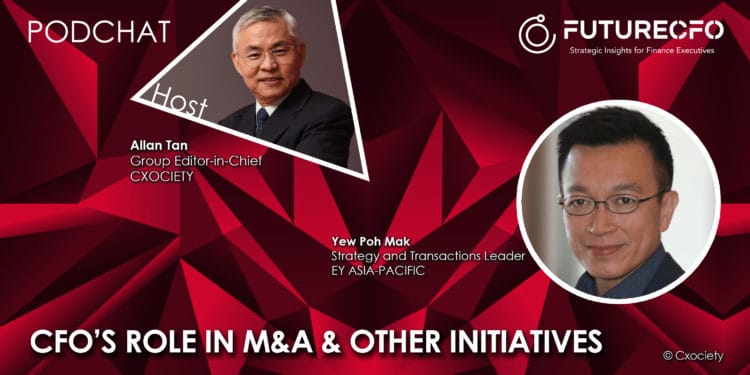According to S&P Global, APAC M&A activity in Q1 2022 retreated from 2021’s highs, with deal value for the quarter ending at $73.8B, a decline of 44% quarter-on-quarter (QoQ) or 18% year-on-year (YoY).
In Q1 2022, Australia (US$15 billion) led the region by transaction value, followed by China (US$12.5 bn) and Hong Kong (US$11.4 bn). The financial services sector topped M&A activities in Q1 2022 with 14.6 billion followed by real estate (US$13.4 bn) and communications (US$9.2 bn).
In a separate analysis, M&A data by EY teams noted that despite the decline in the volume and value of deals, activity is significantly up compared to H1 2020 (up 85% by value and 29% by volume) and remains in line with the average of the last M&A cycle (up 6% and 3% respectively).
Further analysis by EY teams also noted that the nature of cross-border deals is changing to reflect geopolitical tensions on the world stage.
Yew Poh Mak, EY Asia-Pacific strategy and transactions leader, added that in 2022, both deal value and volume have come down, but there is still a very robust M&A environment in APAC. Countries like Japan, China and Australia constitute about 70% of deal activities in APAC and despite the slowdown, the M&A environment across the region continues to be strong.
In one dialogue on M&A activities, it was revealed to FutureCFO that one of the biggest changes to the M&A process during the pandemic was how due diligence was conducted, including how a deal is documented and closed. Meeting formats have changed from face-to-face to almost entirely using virtual platforms such as Microsoft Teams and Zoom.
Mak said the pandemic has proved that physical presence isn’t always needed as everything has moved online.
“Covid has caused many companies to harness digital transformation and have taken advantage of the opportunity to move everything online, from supply chain to customer experience,” he added.
ESG and the CFO
One of the notable observations during the pandemic has been the increased attention placed on environmental, social and governance (ESG) topics. Mak acknowledged that for larger corporations in key markets where ESG has a very strong focus, like Singapore, Australia, and Japan, there is usually the appointment of a Chief Sustainability Officer (CSO).
That said, he also acknowledged the growing involvement of CFOs in deal-making that pushes the sustainability agenda. “The challenge is how to drive sustainability while balancing the short and long-term company objectives,” he added.
“Nonetheless, CFOs and CSOs will often work closely on deals because CFOs are responsible for sustainability reporting in Asia Pacific. The roles of CFOs and CSOs should be regarded as equal given they work together to support the strategic agenda of a business,” Mak opined.
How M&A will evolve in 2023
Despite the interest in M&A as a growth strategy, macroeconomic occurrences such as the ongoing Ukraine-Russian war, rising inflation, and unpredictable disruptions in supply chains will continue to place challenges on how organisations pursue these opportunities.
Mak pointed out that the cost of borrowing has risen, so companies that need to leverage funds for deals may face headwinds, something that CFOs will need to work through.
“With the current geopolitical situation, deal-making could turn inwards as companies look at opportunities within their jurisdiction and market. In countries like Japan, China and Australia, there are significant opportunities for growth and acquisition, so there may be a lesser focus on cross-border deals,” he posited.
The strategic purpose of M&A in 2023
Mak believes that M&As are becoming more strategic with companies looking at how they can use them as a tool for transformation. “For this, companies will be looking at mid to long-term strategic objectives, rather than buying revenue and buying profits,” he opined.

“We shouldn’t forget the ESG agenda, which is also a transformation agenda, but is less operationally focused on the company and more focused on the sustainability theme as a whole, which will ladder up to the CEO’s objectives.”
Yew Poh Mak
The evolving role of CFO in M&A
Mak believes that during a deal, the CFO will still work with the business on due diligence and finance. They are responsible for ensuring the deal is funded, and that corporate governance is in place, while also acting as the liaison between internal and external legal counsel.
“However, due to sustainability and transformation, CFOs are moving beyond their operational role and into a more strategic one, as they look to assess how each deal could benefit the entire enterprise, especially when reporting,” he added.
Overstretched CFOs
Asked whether with all of the responsibilities placed on them, are CFOs able to be effective without ‘dropping the ball’, Mak responded that the key thing for CFOs to think about is where they need capabilities.
Citing as an example, treasury capabilities to take care of funding and balance sheet, he added that building up these capabilities will give CFOs the chance to move away from the operational aspects of their role and instead focus on the bigger picture by working closely with other key stakeholders within the business, like the Chief Executive Officer, Chief Sustainability Officer, or Chief Strategy Officer.
Click on the PodChat player AS Mak goes deeper into the trends shaping the M&A landscape in Asia.
- Give us a quick recap of the M&A landscape in the Asia Pacific from 2020 to today.
- What new things have M&A teams learned since then?
- Given all the concerns of the business – the rising inflation, slowing economies, socio-political instability, and rising importance of ESG – how do you see M&A shifting in 2023?
- Is pursuing M&A for growth a sustainable strategy? If not growth, what should be the strategic purpose of M&A?
- How has the involvement of CFOs in M&A activities changed since the start of the pandemic?
- With the CFO to-do list expanding, how should CFOs evolve their work habits to fulfil the expectations placed on them, while remaining effective both on the table stakes responsibilities as well as emerging roles in activities like M&A and ESG?
- a. In other words, how can the CFO achieve all of what is expected of the role without dropping the ball?




